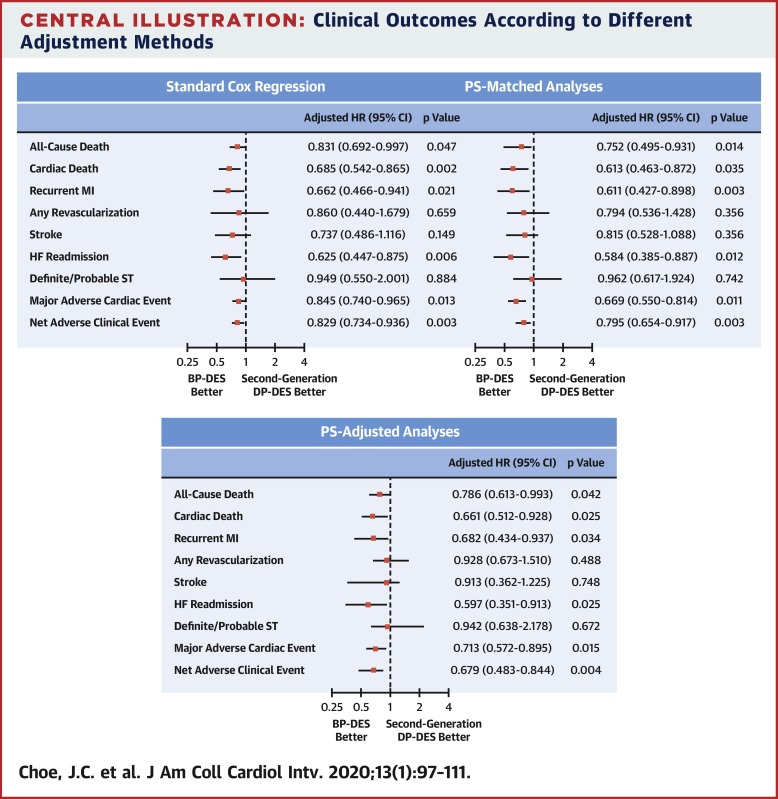当前位置:
X-MOL 学术
›
JACC Cardiovasc. Inte.
›
论文详情
Our official English website, www.x-mol.net, welcomes your
feedback! (Note: you will need to create a separate account there.)
Long-Term Outcomes of Biodegradable Versus Second-Generation Durable Polymer Drug-Eluting Stent Implantations for Myocardial Infarction.
JACC: Cardiovascular Interventions ( IF 11.7 ) Pub Date : 2020-01-13 , DOI: 10.1016/j.jcin.2019.08.020 Jeong Cheon Choe 1 , Kwang Soo Cha 2 , Jeong Gyu Lee 3 , Jinmi Kim 4 , Ji Yeon Shin 2 , Jinhee Ahn 2 , Jin Sup Park 2 , Hye Won Lee 2 , Jun-Hyok Oh 2 , Jung Hyun Choi 2 , Han Cheol Lee 2 , Taek Jong Hong 2 , Myung Ho Jeong 5 ,
JACC: Cardiovascular Interventions ( IF 11.7 ) Pub Date : 2020-01-13 , DOI: 10.1016/j.jcin.2019.08.020 Jeong Cheon Choe 1 , Kwang Soo Cha 2 , Jeong Gyu Lee 3 , Jinmi Kim 4 , Ji Yeon Shin 2 , Jinhee Ahn 2 , Jin Sup Park 2 , Hye Won Lee 2 , Jun-Hyok Oh 2 , Jung Hyun Choi 2 , Han Cheol Lee 2 , Taek Jong Hong 2 , Myung Ho Jeong 5 ,
Affiliation

|
OBJECTIVES
This study sought to compare outcomes between biodegradable polymer drug-eluting stent (BP-DES) and second-generation durable polymer drug-eluting stent (DP-DES) implantations for acute myocardial infarction (MI) using a nationwide dataset.
BACKGROUND
Data regarding outcomes of BP-DES versus second-generation DP-DES are inconclusive.
METHODS
Among 13,104 patients with acute MI in a nationwide registry who underwent percutaneous coronary intervention (November 2011 to December 2015), BP-DES and second-generation DP-DES were implanted in 2,261 (21.7%) and 8,182 patients (78.3%), respectively. Major adverse cardiac events (MACE) (all-cause death, recurrent MI, or any revascularization) were compared in multivariable Cox regression, propensity score (PS) matched, and underwent PS-adjusted analyses.
RESULTS
MACE occurred in 1,492 (14.3%) patients during a median 723-day follow-up. MACE were less frequent with BP-DES implantation than with second-generation DP-DES implantation (entire cohort hazard ratio [HR]: 0.845; 95% confidence interval [CI]: 0.740 to 0.965; PS-matched HR: 0.669; 95% CI: 0.550 to 0.814). Risk of all-cause death (entire cohort HR: 0.831; 95% CI: 0.692 to 0.997; PS-matched HR: 0.752; 95% CI: 0.495 to 0.931), cardiac death (entire cohort HR: 0.685; 95% CI: 0.542 to 0.865; PS-matched HR: 0.613; 95% CI: 0.463 to 0.872), recurrent MI (entire cohort HR: 0.662; 95% CI: 0.466 to 0.941; PS-matched HR: 0.611; 95% CI: 0.427 to 0.898), and heart failure readmission (entire cohort HR: 0.625; 95% CI: 0.447 to 0.875; PS-matched HR: 0.584; 95% CI: 0.385 to 0.887) was less with BP-DES implantation. There were no significant group differences in the incidences of any revascularization, stroke, and definite or probable stent thrombosis.
CONCLUSIONS
In patients with acute MI who underwent percutaneous coronary intervention, BP-DES implantation is associated with improved outcomes compared with second-generation DP-DES implantation.
中文翻译:

可生物降解与第二代耐用聚合物药物洗脱支架植入治疗心肌梗塞的长期结果。
目的本研究试图使用全国性数据集比较可生物降解的聚合物药物洗脱支架(BP-DES)和第二代耐用性聚合物药物洗脱支架(DP-DES)植入治疗急性心肌梗死(MI)的结果。背景技术关于BP-DES与第二代DP-DES的结局数据尚无定论。方法在2011年11月至2015年12月,在全国登记的13104例急性心肌梗死患者中,分别进行了BP-DES和第二代DP-DES植入,分别为2,261例(21.7%)和8,182例(78.3%),分别。在多变量Cox回归,倾向评分(PS)匹配并进行PS校正分析的情况下,比较了主要不良心脏事件(MACE)(全因死亡,复发性MI或任何血运重建)。结果MACE发生于1,492(14。3%)患者在723天的中位随访期间。与第二代DP-DES植入相比,MACE的发生率较低(整个队列风险比[HR]:0.845; 95%置信区间[CI]:0.740至0.965; PS匹配的HR:0.669; 95% CI:0.550至0.814)。全因死亡的风险(整个队列HR:0.831; 95%CI:0.692至0.997; PS匹配的HR:0.752; 95%CI:0.495至0.931),心源性死亡(整个队列HR:0.685; 95%CI: 0.542至0.865; PS匹配HR:0.613; 95%CI:0.463至0.872),复发性MI(整个队列HR:0.662; 95%CI:0.466至0.941; PS匹配HR:0.611; 95%CI:0.427至植入BP-DES时,心衰再入院率(整个队列HR:0.625; 95%CI:0.447至0.875; PS匹配HR:0.584; 95%CI:0.385至0.887)较少。在任何血运重建,中风以及明确或可能的支架血栓形成的发生率方面,均没有显着的群体差异。结论在接受了经皮冠状动脉介入治疗的急性心肌梗死患者中,与第二代DP-DES植入相比,BP-DES植入可改善预后。
更新日期:2020-01-07
中文翻译:

可生物降解与第二代耐用聚合物药物洗脱支架植入治疗心肌梗塞的长期结果。
目的本研究试图使用全国性数据集比较可生物降解的聚合物药物洗脱支架(BP-DES)和第二代耐用性聚合物药物洗脱支架(DP-DES)植入治疗急性心肌梗死(MI)的结果。背景技术关于BP-DES与第二代DP-DES的结局数据尚无定论。方法在2011年11月至2015年12月,在全国登记的13104例急性心肌梗死患者中,分别进行了BP-DES和第二代DP-DES植入,分别为2,261例(21.7%)和8,182例(78.3%),分别。在多变量Cox回归,倾向评分(PS)匹配并进行PS校正分析的情况下,比较了主要不良心脏事件(MACE)(全因死亡,复发性MI或任何血运重建)。结果MACE发生于1,492(14。3%)患者在723天的中位随访期间。与第二代DP-DES植入相比,MACE的发生率较低(整个队列风险比[HR]:0.845; 95%置信区间[CI]:0.740至0.965; PS匹配的HR:0.669; 95% CI:0.550至0.814)。全因死亡的风险(整个队列HR:0.831; 95%CI:0.692至0.997; PS匹配的HR:0.752; 95%CI:0.495至0.931),心源性死亡(整个队列HR:0.685; 95%CI: 0.542至0.865; PS匹配HR:0.613; 95%CI:0.463至0.872),复发性MI(整个队列HR:0.662; 95%CI:0.466至0.941; PS匹配HR:0.611; 95%CI:0.427至植入BP-DES时,心衰再入院率(整个队列HR:0.625; 95%CI:0.447至0.875; PS匹配HR:0.584; 95%CI:0.385至0.887)较少。在任何血运重建,中风以及明确或可能的支架血栓形成的发生率方面,均没有显着的群体差异。结论在接受了经皮冠状动脉介入治疗的急性心肌梗死患者中,与第二代DP-DES植入相比,BP-DES植入可改善预后。











































 京公网安备 11010802027423号
京公网安备 11010802027423号